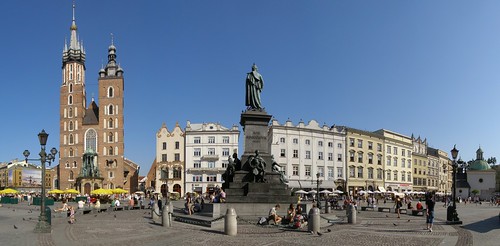Trzech wspaniałych…. Posted by Kasia on Jun 6, 2014 in Uncategorized
Today, the dominating bronze statue (posąg z brązu) that looms over the pigeons of Kraków’s Rynek Głόwny is a favourite meeting place for tourists, guide groups and pub crawls. However, the man it depicts should not be lost to any visitor to Poland; his importance as a de facto leader of the Polish national struggle during the period of partition cannot really be overstated.
This is Adam Mickiewicz, the most successful of all Polish poets, and accordingly the most revered (czczony). Most of his work was completed in exile (na wygnaniu), in countries in central and Western Europe, where sympathy for Poland’s national struggle was easier to find.
His style is one that characterised and influenced the path of European romanticism – then the dominant literary movement (dominujący ruch literacki) on the continent. He popularised the use of medieval and folkloric themes, along with traditional romantic motifs (romantyczne motywy), that he used to produce powerful ‘state of the nation’ literature.
Mickiewicz’s magnum opus (praca, dzieło) is the epic Pan Tadeusz. Today, it is studied in all Polish schools and quickly became a contemporary example of nationalistic literature for its lamentation of the loss of a Polish-Lithuanian homeland. It’s a theme echoed too in many of his minor works, like Konrad Wallenrod, which constructs a light metaphor for the lasting national rivalry of Russia and Poland through the image of the historical enmity (wrogość) of Lithuanian pagans and the Teutonic order.
The second of the ‘three bards’ participated first hand in the Polish resistance to Russian partitioning during the uprising of 1830, but lived much of his life and exile…We are talking about Juliusz Słowacki. Słowacki’s work is varied and voluminous and he produced poems in a number of a styles, some anachronistic to the literary trends of the age. That said, he often adopted the typically romantic motifs of mysticism and the sublime (motywy mistycyzmu i wzniosłości).
Thoroughly nationalistic, Słowacki’s productions were overtly patriotic; they reworked traditional Slavic myths into images of a contemporary and divided Poland that served – especially in the latter period of his life – to stir the national pride of Poland’s youth to movement against the Russian yoke. His remains were moved to the Wawel Cathedral in Kraków, where he now lays next to Mickiewicz in the ‘tomb of the Polish bards’.
Zygmunt Krasiński is the most widely accepted choice for the third member of the Polish bards, however it’s something often contested by literary critics, probably due to his more conservative tendencies and adoption of excessively religious, rather than nationalistic and romantic, themes. He was born in exile and died in exile, but did study alongside Mickiewicz in Poland.
One of his best known works, the Nie-boska Komedia , imagines a dystopic world, where the traditionalist noble-led societal system is torn apart by the invading forces of communism on the one side, and democracy on the other, and is an example of Krasiński’s place as the least radical of the three bardic Polish poets. Unlike his contemporaries, who called for a new and reinvigorated Poland, risen from the ashes and shaped by the new-radicals of the youth, Krasiński apotheosised traditional Polish values into a messianic image of the past.
The so-called ‘three bards’ have the epithet because they were champions of Polish culture and national character in a period when it was most needed. They were by no means the only literary figures on the contemporary stage, but they do remain the most remembered in Poland today.
Do następnego razu… (Till next time…)

Build vocabulary, practice pronunciation, and more with Transparent Language Online. Available anytime, anywhere, on any device.
About the Author: Kasia
My name is Kasia Scontsas. I grew near Lublin, Poland and moved to Warsaw to study International Business. I have passion for languages: any languages! Currently I live in New Hampshire. I enjoy skiing, kayaking, biking and paddle boarding. My husband speaks a little Polish, but our daughters are fluent in it! I wanted to make sure that they can communicate with their Polish relatives in our native language. Teaching them Polish since they were born was the best thing I could have given them! I have been writing about learning Polish language and culture for Transparent Language’s Polish Blog since 2010.





